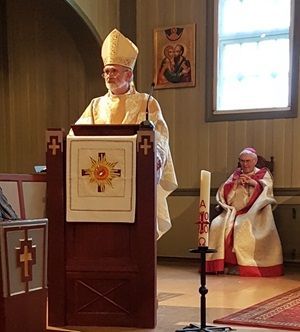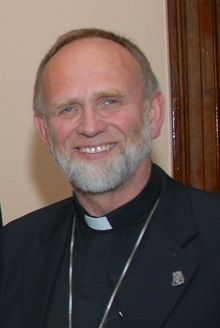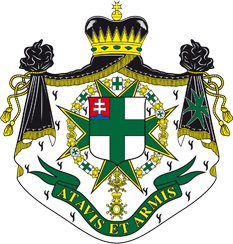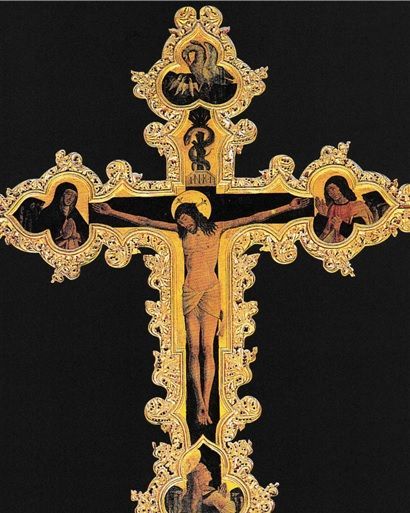Meditácia na Veľký piatok od Rev. Ottar Mikael Myrseth, ECLJ, biskupa severskokatolíckej cirkvi škandinávskej diecézy.
MEDITAZIONE PER IL VENERDI’ SANTO DEL MOLTO REV.DO OTTAR MIKAEL MYRSETH, ECLJ, VESCOVO DELLA CHIESA NORDICA CATTOLICA DIOCESI DI SCANDINAVIA
(Crocifisso dipinto su tavola, di Pietro Ruzzolone, il “Raffaello di Sicilia”, 1484, Duomo di Termini Imerese)
Carissimi Confratelli e Consorelle dell’Ordine Militare ed Ospedaliero di San Lazzaro di Gerusalemme,
Il segno della croce è il più importante e forte dei simboli cristiani. Oggi è usato e abusato. Nelle bandiere, negli annunci funebri, al collo e come orecchini. Forse non ci strazia più l’anima a vederlo. Si è acclimatato.
Tuttavia, questo mezzo di esecuzione era così terribile che persino gli antichi Romani smisero presto di usarlo. Ma la croce racconta il costo della nostra salvezza.
La verità fondamentale della nostra religione è che siamo salvati da una morte in croce. La vita spirituale non è una questione di buon umore e di luci di candela, ma di sangue, sudore, lacrime e dolore, chiodi e ferite, sottomissione e tremore della morte. Un’esperienza molto corporea.
Gli uomini erano vinti dal peccato e dalla morte. La terra era diventata un luogo dove nessuna preghiera poteva essere ascoltata. Allora la croce di Dio fu eretta su di noi. Per evitare questo la nostra croce doveva essere.
Mileto di Sardi dice questo sul Venerdì Santo nella sua famosa omelia pasquale: „Perché quando il popolo non tremava, la terra tremava. Quando il popolo non temeva, i cieli avevano paura. Quando il popolo non si stracciò le vesti, l’angelo si stracciò le sue. Quando il popolo non si lamentava, il Signore tuonava dal cielo e l’Altissimo dava voce“.
Da allora la croce è un simbolo controverso. Simbolo di esecuzione e ancora oggi il più bel segno di vita. Espressione di due delle sette parole pronunciate da nostro Signore sulla croce.
La prima parola di Gesù sulla croce fu: „Padre, perdona loro, non sanno quello che fanno“. Egli fa della croce un simbolo del volto dell’amore.
Il nostro amore dice: „Ti amo perché“. Questo è l’amore che cerca il suo, quello che può soddisfarlo.

(Molto Reverendo Ottar Mikael Myrseth)
Ma l’uomo sulla croce chiede perdono per gli assassini e rinuncia alla sua vita per gli innocenti. Senza aspettarsi nulla in cambio. Ama, ma non si aspetta di essere amato. Ha rinunciato alla sua vita celeste per un’umiliazione terrena. Ha rinunciato alla sua innocenza per essere crocifisso come colpevole. Ha rinunciato alla sua purezza per essere ucciso come peccatore. Ha lasciato andare i suoi amici mentre lui stesso veniva arrestato. Li lascia vivere mentre lui muore.
L’ultima parola di Gesù sulla croce è stata: „È finita!“. Ha fatto della croce un segno di riconciliazione. Le profezie si sono compiute. Il piano di Dio è stato portato a compimento. Ciò che Mosè ha intravisto quando ha sollevato il serpente di rame sull’asta nel deserto, è diventato realtà. Ciò che Abramo ha intuito quando non ha dovuto sacrificare Isak, ha avuto la sua risposta. L’ultimo dei colpi di Noè nella costruzione dell’arca è stato martellato nella croce del Golgata.
La riconciliazione è possibile per coloro che si lasciano riconciliare.
Questa croce è diventata il segno per i seguaci. „Se qualcuno vuole seguirmi, rinneghi se stesso, prenda la sua croce e mi segua. Perché chi vorrà salvare la propria vita la perderà, ma chi perderà la propria vita per causa mia la troverà“. I seguaci di Gesù sono persone che hanno visto il volto dell’amore e hanno sperimentato la forza della riconciliazione nella loro vita.
Nostro Signore, il Portatore di Croce, ci invita a vivere una vita libera da preoccupazioni personali.
Egli insegna che la lussuria è un fardello più pesante dell’amore, l’odio un carico più pesante della riconciliazione e la vendetta più pesante del sacrificio di sé.
Questo è il suo giogo. Questo è il segno di croce del Venerdì Santo.
+ Ottar Mikael Myrseth, ECLJ,
Vescovo della Chiesa Cattolica Nordica, Diocesi Scandinava
MEDITATION FOR THE GOOD FRIDAY BY THE RT. REV. OTTAR MIKAEL MYRSETH, ECLJ, BISHOP OF THE NORDIC CATHOLIC CHURCH SCANDINAVIAN DIOCESE

(Crucifixion – 14th century fresco -Monastery of St. Benedict – Sacro Speco of Subiaco)
Dear Confreres and Sisters of the Military and Hospitaller Order of St Lazarus of Jerusalem,
The sign of the cross is the far most important and strongest of Christian symbols. Today used and misused. In flags, in funeral announcements, around the neck and as earrings. It might no longer tear up our soul to see it. It has become acclimatized.
However this means of execution was actually so terrible that even the old Romans early stopped using it. But the cross tells the cost of our salvation.
The basic truth of our religion is that we are saved by a death on a cross. Spiritual life is not a question of good mood and candle lights, but of blood, sweat, tears and pain, nails and wounds, submission and death trembling. A most bodily experience.
Men were overcome by sin and death. The earth had become a place where no prayers could be heard. Then Gods cross was erected over us. To avoid that our cross had to be.
Mileto of Sardes says this about Good Friday in his famous Easter homily:
«For when the people did not tremble, the earth shook. When the people did not fear, the heavens were afraid. When the people did not rend their garments, the angel rent his own. When the people did not lament, the Lord thundered from heaven, and the most high gave voice.»
Since then the cross has stood as a controversial symbol. Symbol of execution and still the most beautiful sign of life. Expressed in two of the seven words of our Lord on the cross:
Jesus’ first word on the cross was: «Father, forgive them, they do not know what they are doing.» He makes the cross a symbol of the face of love.
Our love says «I love you because». This is the love that seeks its own, what can satisfy it.
But the man on the cross asks forgiveness for the murderers and gives up his life for the innocent. Without expecting anything in return. He loves, but does not expect to be loved. He gave up his heavenly life for an earthly humiliation. He gave up his innocence to be crucified as guilty. He gave up his purity to be killed as sinner. He lets his friends go as he himself is arrested. He let them live as he dies.
Jesus last word on the cross was: «It is finished!» He made the cross a sign of reconciliation. The prophecies were fulfilled. Gods plan was lead to completion. What Moses glimpsed when he lifted the copper snake on the pole in the desert, has become true. What Abraham guessed when he did not have to sacrifice Isak, got its answer. The last of the blows of Noah building the ark, was now hammered into the cross at Golgata.
Reconciliation is avilable for those who will be reconciled.

(Rt. Rev. Ottar Mikael Myrseth)
This cross has become the sign for followers. «If anyone desires to follow me, let him deny himself and take his cross up an follow me. For whoever desires to save his life will lose it, but whoever loses his life for my sake will find it.» Jesus-followers are people who has seen the face of love and experienced the power of reconciliation in their own lives.
Our Lord, the Crossbearer, invites us to live a life free from self-concerns.
He teaches that lust is a heavier burden than love, hate a heavier load than reconciliation and revenge heavier than self-sacrifice.
This is how his yoke is. This is the crossmarked Good Friday.
+ Ottar Mikael Myrseth, ECLJ,
Bishop of the Nordic Catholic Church, Scandinavian Diocese
UDALOSTI
- Grand Hospitaller Report 2023 27. júna 2024
- Podpora vzdelávacieho procesu na školách 7. júna 2024
- Investitúra 2024 25. mája 2024
- Pozvánka na investitúru 2024 17. mája 2024
- Charitatívna činnosť 15. mája 2024

 Military and Hospitaller Order of St.Lazarus of Jerusalem Grand Priory Slovakia,
Military and Hospitaller Order of St.Lazarus of Jerusalem Grand Priory Slovakia,